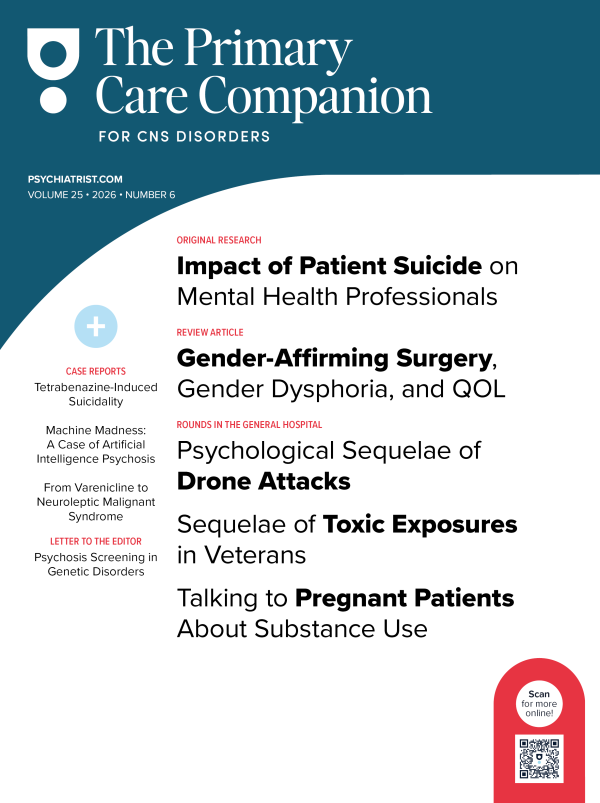Because this piece does not have an abstract, we have provided for your benefit the first 3 sentences of the full text.
To the Editor: Olanzapine and clozapine are structurally similar dibenzodiazepines with some overlapping adverse effects. However, while drug-induced fever is considered a frequent side effect associated with clozapine, it has rarely been described with olanzapine. Current hypotheses conjecture an induction of fever due to dopaminergic antagonism that would elevate the hypothalamic thermoregulatory set point and the production of endogenous pyrogens, with consequent release of local cytokines.
To the Editor: Olanzapine and clozapine are structurally similar dibenzodiazepines with some overlapping adverse effects. However, while drug-induced fever is considered a frequent side effect associated with clozapine, it has rarely been described with olanzapine.1,2 Current hypotheses1-3 conjecture an induction of fever due to dopaminergic antagonism that would elevate the hypothalamic thermoregulatory set point and the production of endogenous pyrogens, with consequent release of local cytokines.
Case report. The patient was a 35-year-old married man who was currently unemployed. He had no prior medical, surgical, or psychiatric history and was taking no medication. He had a history of tobacco use (he smoked a pack per day for 17 years) and cannabis use (7-8 times per day since 18 years of age). Family history revealed his father’s diagnosis of posttraumatic stress disorder. For the past 5 years, the patient had developed a persecutory delusion directed at his neighbors, leading to frequent changes of residence (3 in the last year). In the month prior to hospitalization, he reported auditory-verbal hallucinatory activity, with hetero-aggressiveness, constant soliloquy, anguish, and total insomnia. These symptoms led to admission to the emergency department and compulsory hospitalization. At admission, the patient was conscious, uncooperative, partially oriented in time, oriented in space, and emaciated. He exhibited a dysphoric mood, verbalized ideas of persecutory content with auditory hallucinatory activity and no insight, and refused treatment.
A therapeutic regimen of olanzapine 20 mg/d was given on days 1-4 and increased to 25 mg/d on days 5-18 (due to lack of response). Additionally, flurazepam 15 mg at bedtime was started on day 1. The benzodiazepine lorazepam was prescribed on days 1-10 (maximum lorazepam dose: 5 mg/d) and cyamemazine 100 mg on days 7-18. Since day 11 of hospitalization, a constant elevation of body temperature was observed, with a minimum tympanic temperature of 98.96°F (37.2°C) and febrile peaks on days 11, 12, 14, and 16 (100.76°F [38.2°C] to 101.48°F [38.6°C]). Laboratory findings during hospitalization pointed to negative viral parameters (human immunodeficiency virus, hepatitis B and C, venereal disease research laboratory, Borrelia) and negative creatine kinase and antinuclear antibodies, with sustained mild neutrophilia (7,600 ח 10^3/mL) with no leukocytosis and polymerase chain reaction of 3 mg/dL. Both thorax radiography and head computed tomography scans were within normal limits. During these days of persistent temperature rise, no autonomic instability, changes in consciousness, muscle stiffness, or other signs of infection were observed. Olanzapine was discontinued at discharge (day 18), with resolution of temperature elevation. On the third day post discharge, the patient took 5 mg of olanzapine (as-needed regimen), with subsequent recurrence of fever that resolved in less than 24 hours with no need for antipyretics.
The adverse effect was reported to the National Pharmacovigilance system. We applied the scale of adverse drug reaction4 and obtained a score of 6, which indicated that olanzapine was a probable causal factor of the patient’s fever. The appearance of fever during antipsychotic treatment cautions the presence of neuroleptic malignant syndrome, which was also excluded in this case. In conclusion, there is a probable causal association between olanzapine and fever, with the notable reappearance of the signal after the isolated administration of 5 mg in the post discharge period.
References
1. Yang C-H, Chen Y-Y. A case of olanzapine-induced fever. Psychopharmacol Bull. 2017;47(1):45-47. PubMed
2. Kluge M, Schuld A, Schacht A, et al. Effects of clozapine and olanzapine on cytokine systems are closely linked to weight gain and drug-induced fever. Psychoneuroendocrinology. 2009;34(1):118-128. PubMed CrossRef
3. Szota A, Oglodek E, Araszkiewicz A. Fever development in neuroleptic malignant syndrome during treatment with olanzapine and clozapine. Pharmacol Rep. 2013;65(2):279-287. PubMed CrossRef
4. Naranjo CA, Busto U, Sellers EM, et al. A method for estimating the probability of adverse drug reactions. Clin Pharmacol Ther. 1981;30(2):239-245. PubMed CrossRef
aServiço de Psiquiatria, Hospital Prof Doutor Fernando da Fonseca, Amadora, Portugal
bDepartamento de Psiquiatria e Saúde Mental, Hospital do Esp×rito Santo de Évora, EPE, Évora, Portugal
Potential conflicts of interest: Dr Ferreira reports nonfinancial support from Janssen-Cilag, Lundbeck Portugal, and Angelini. Dr Godinho reports nonfinancial support from Janssen-Cilag, Lundbeck Portugal, Servier Portugal, and Tecnifar. Dr Dehanov reports nonfinancial support from Janssen-Cilag, Lundbeck Portugal, and Angelini. Drs Trancas and Maia report nonfinancial support from Janssen-Cilag, Lundbeck Portugal, Eli Lilly, Servier Portugal, AstraZeneca PLD, and Wyeth Lederle.
Funding/support: None.
Patient consent: Consent was received from the patient to publish the case report, and information has been de-identified to protect anonymity.
Published online: February 28, 2019.
Prim Care Companion CNS Disord 2019;21(1):18l02332
To cite: Ferreira TF, Godinho FDG, Dehanov SD, et al. Olanzapine-induced fever. Prim Care Companion CNS Disord. 2019;21(1):18l02332.
To share: https://doi.org/10.4088/PCC.18l02332
© Copyright 2019 Physicians Postgraduate Press, Inc.
Please sign in or purchase this PDF for $40.00.


